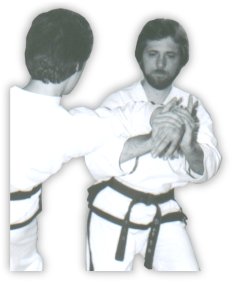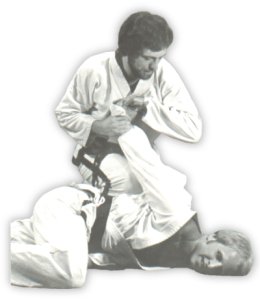There are no records which indicate exactly when kwan jyel sul (joint
manipulation techniques) were first used. There is little doubt that there
are many isolated examples of individuals using kwan jyel techniques.
However, kwan jyel sul, as either a method of self-defense or a means of
healing, can be traced back to Buddhist monks of India. Though many different
countries practice some form of kwan jyel sul today, I shall direct my
attention to the major uses of kwan jyel techniques of ancient times and
today.
 The development of kwan jyel sul is closely related to the creation of
acupuncture and the healing arts, and the arts of self-defense. It is
generally accepted that the idea of acupuncture began about 2698 BC.
This is when the book titled, The Emperor's Internal Book,
was written. Acupuncture is an oriental system of medicine in which
needles are placed at different points in the body in order to help
cure illnesses, relieve pain and stimulate
the normal balance within the body. Part of learning the art
of acupuncture was the practice of acupressure. Acupressure deals with
curing medical problems such as pain, which can be caused by many things
including; pinched nerves, dislocated bones, and sore muscles.
The development of kwan jyel sul is closely related to the creation of
acupuncture and the healing arts, and the arts of self-defense. It is
generally accepted that the idea of acupuncture began about 2698 BC.
This is when the book titled, The Emperor's Internal Book,
was written. Acupuncture is an oriental system of medicine in which
needles are placed at different points in the body in order to help
cure illnesses, relieve pain and stimulate
the normal balance within the body. Part of learning the art
of acupuncture was the practice of acupressure. Acupressure deals with
curing medical problems such as pain, which can be caused by many things
including; pinched nerves, dislocated bones, and sore muscles.
In order to help cure those who needed medical treatment, the monks used
kwan jyel sul. The techniques used to help cure people were part of the
healing methods which involved the manipulation of the joints.
If a person had a pinched nerve in his arm, the monks would apply
pressure to different portions of the spine as they manipulated it in different directions.
Dislocated joints, such as elbows, were helped by re-setting the elbow by
rotating and pulling on the arm until the joint was set properly. Headaches
were cured by kwan jyel neck manipulation techniques. The manipulation of the
joints, as the monks learned, worked not only the joints themselves, but the
muscles, tendons, blood vessels, and nerves, all at the same time.
The monks, with their vast knowledge of human anatomy through research in this
area, were able to adapt this knowledge to their methods of self-defense.
They learned how to use the joints to control an opponent. They used their
kwan jyel sul for defending the monasteries. They also used their self-defense
techniques to protect themselves from bandits and wild animals on their
travels throughout the country.
As the monks traveled to different countries, they took with them their
knowledge of kwan jyel sul. They spread these techniques and principles to
China, Korea, and Japan. Kwan jyel sul took on other names, such as
Chin-Na in China. Kwan jyel techniques were used by the military for defending their
countries and driving off invaders. Many styles incorporate the use of kwan
jyel sul as part of their training.
The guards were not allowed to use weapons on the palace grounds
unless it became absolutely necessary. Therefore, they would rely heavily on
their knowledge of kwan jyel sul, which was taught to them primarily by the
Korean Buddhist monks. Any intruder who happened to venture onto the palace
grounds quickly found himself on the receiving end of a kwan jyel technique.
Some of the women who attended to the needs of the ladies of the Korean royal court
were also trained in the art of Koong Jong Mu Do, and thus, kwan jyel sul. In
addition to their regular duties, these women were actually the bodyguards of
the members of the royal court. They would gladly give up their lives for
their lord or lady.
It was not uncommon for Korean noblemen to surround themselves with beautiful
women servants. In actuality, these noblemen were protected by the most
attractive but deadly bodyguards one could imagine. Though pleasing to the
eye, these young women could easily dispatch anyone who threatened the safety
of their lord or lady. Their knowledge of kwan jyel sul gave them the ability
to neutralize an opponent with the use of little force.
 The famed Hwa Rang warriors of the ancient Korean Kingdom of Silla were also
well versed in the use of kwan jyel sul. The Hwa Rang was a group of young
warriors who, during the period when Korea was divided into three different
Kingdoms, became a main instrument in the victories of the Kingdom of Silla
over the other two neighboring Kingdoms. Through their valiant efforts, they
unified the Three Kingdoms and created one nation. Kwan jyel sul was one of
the most important aspects of the Hwa Rang's training.
The famed Hwa Rang warriors of the ancient Korean Kingdom of Silla were also
well versed in the use of kwan jyel sul. The Hwa Rang was a group of young
warriors who, during the period when Korea was divided into three different
Kingdoms, became a main instrument in the victories of the Kingdom of Silla
over the other two neighboring Kingdoms. Through their valiant efforts, they
unified the Three Kingdoms and created one nation. Kwan jyel sul was one of
the most important aspects of the Hwa Rang's training.
Won Kang taught many different forms of defense to the Hwa Rang including the
use of kwan jyel sul (joint manipulation techniques), and hyel do sul (vital
point techniques), plus how to use ji pang e sul (cane techniques), as well as
a variety of different weapons. They learned how, by manipulating the joints,
they were able to expose the hyel do points of their opponent and terminate
him. They were taught how to position the joints so the opponent would be
paralyzed. They were also taught how to heal their wounds through their
knowledge of both Kwan Jyel Sul and acupressure.
Many of the soldiers who trained under their Hwa Rang leaders also learned
some kwan jyel sul. There are those who claim only the Hwa Rang were taught
kwan jyel sul and not the regular troops. This is not true! Many troops were
trained by their Hwa Rang leaders or by other specially trained
officers whose responsibility it was to train their men for battle. Though
the average soldier did not have an extensive knowledge of kwan jyel sul, they
did however have some knowledge of kwan jyel techniques. After leaving the
military, or being transferred to another location, they began teaching others
the self-defense arts they had learned, including the use of kwan jyel
techniques. Thus, Kwan Jyel Sul continued to expand and develop as the
martial arts and Buddhism spread. As you can see, wherever you found the
martial arts, you found Kwan Jyel techniques. Wherever a Buddhist monastery
was erected the techniques of kwan jyel continued to evolve and develop.
China also used kwan jyel sul in their military arts of self-defense and
in the healing arts. Their country uses the term chin-na. It deals not only
with the physical principles of joint manipulation but with the concept of Chi
(pronounced chee). Chi (Gi "Gee" in Korean, Ki "Kee" in Japanese), is our
life energy. Without it we would die. Our body is filled with Chi which is
continuously entering and leaving our body as we exert energy, either through
physical activity or mental activity. Chi enters our bodies through the air
we breath and the food we eat. If an imbalance occurs in our chi, we become
sick. If we fail to correct the imbalance and it grows worse, we could die.
Using the meridians (paths which Chi follows throughout our bodies), the
Chinese were able to execute kwan jyel sul and control their opponent or
inflict damage upon their enemy either instantaneously or delay the opponent's
reaction until a much later time. The techniques of kwan jyel sul used in
Chinese chin na are, if studied for a long period of time, quite effective.
Kwan jyel sul can also be found in Japan. It was used by the infamous
Japanese ninja. They developed kwan jyel techniques to a fine art and used
them with extreme effectiveness and deadly cunning. Kwan jyel sul flowed into
almost every form of martial arts of Japan. It can be found being taught to
the Japanese military and the police. The Japanese marital arts of aikido,
and jujitsu rely to a great degree on kwan jyel techniques.
Kwan jyel sul can be found in almost all forms of the martial arts; in China:
chin-na, and other styles of the Chinese fighting arts. In Japan: aikido,
karate, jujitsu, judo, and ninjitsu. In Korea: TaeKwon-Do,
hapkido, hwa rang do, yudo, kuk sool won, yu sool,
and many other Korean styles.
Kwan jyel sul helps doctors cure the ill, law enforcement personal apprehend
criminals, and individuals defend their family and loved-ones. We all use
it in everyday life. Most of us, without thinking about it, or some who do
not realize it at all. Kwan Jyel Sul has always been a part of something
else, never something which was recognized as being as important as it really
is to all of us. The history of Kwan Jyel Sul shows without a doubt that kwan
jyel sul is indeed useful and necessary for all who practice the arts of
healing or self-defense.
The Principles of Kwan Jyel Sul
In order to practice Kwan Jyel Sul (Joint Manipulation Techniques), you must
learn the Principles of Kwan Jyel Sul.
The principles, when applied properly,
are what insure your techniques are applicable. If you do not employ the
principles when constructing and creating your Kwan Jyel techniques, then the
techniques will lack power, accuracy and practicality. Study the principles
of Kwan Jyel Sul carefully. Commit them to memory and use them for analyzing
all of your Kwan Jyel Sul and self-defense techniques.
There are six principles of Kwan Jyel Sul.
The six principles of kwan jyel sul are:
- Manipulation of the Joints.
- Controlling the Muscles.
- Regulating the Breathing.
- Restraining the Blood.
- Direction of Force.
- Body Reaction.
All six of these principles are interrelated. They flow from one to the other until the
techniques develop themselves through almost every movement you or the
opponent makes. Remember, let a "qualified" instructor guide you in your
studies of Kwan Jyel Sul.
The following techniques are from Grand Master Benko's book: "Kwan Jyel Sul: Joint Locks, Holds, & Throws For Self-Defense" .
The techniques are performed by Grand Master James S. Benko, Edna T. Benko, and Curtis Christner.